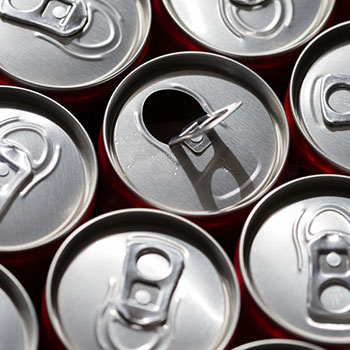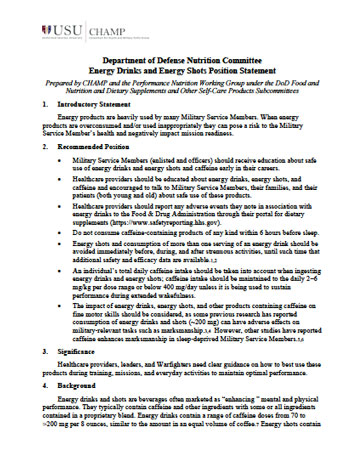You’ve seen them. You’ve heard of them. You’ve probably even tried at least one. Energy drinks and energy shots are sold at gas stations, grocery stores, and on military bases. Many Military Service Members report they consume them frequently, which has given rise to some concern. Energy drinks have been associated with unwanted side effects such as headache, jitteriness, stomach upset, trouble sleeping, and chest pain, all of which can compromise mission readiness.
Avoid using energy drinks or shots before, during, or after strenuous activity and within 6 hours before sleep.
Part of the concern with energy drinks has to do with caffeine. The most popular energy drinks contain anywhere between 114 and 300 mg of caffeine per container (typically 12–16 fl oz, but some energy drinks now come in 24 fl oz cans). Energy shots can contain much more caffeine per serving. Caffeine isn’t necessarily a bad thing. When used appropriately, caffeine can boost mental and physical performance. However, many Military Service Members consume more than one energy drink per day and might also consume other sources of caffeine. Too much caffeine can cause headaches, nervousness, shakiness, and sleep problems. And if “stacked” with dietary supplements, especially ones containing other stimulants, the potential risk for serious side effects is higher than when used alone. Be aware that the amount of caffeine in energy drinks and energy shots isn’t regulated, so it’s important to look at the label and determine how much caffeine is in the product.
Caffeine isn’t the only ingredient in energy drinks and energy shots, though. They often contain taurine, glucuronolactone, B vitamins, herbal extracts, and/or amino acids. Individually, these ingredients are generally safe, but there isn’t enough reliable information about how combinations of the ingredients in energy drinks affect the body, especially long term. Some research on blood pressure suggests energy drinks behave differently in the body than other sources of caffeine. In addition, there is no standard list of ingredients for energy drinks, so some products might contain yohimbe or other stimulants that could be of concern.
Aviators and aircrew personnel in the Army, Air Force, Navy, and Marine Corps should be aware of their branch-specific policies with regard to dietary supplement use, which might include energy drinks. Among the aviation communities in general, dietary, herbal, and/or nutritional supplements can only be used with the approval of a flight surgeon. However, all Military Service Members should be aware of their energy drink intake and keep in mind the following:
- Energy drinks contain various amounts of caffeine, so look at the product label and add it to the amount of caffeine in your daily intake.
- Note: If used to maintain alertness and vigilance during sustained operations, look for products that contain 200 mg of caffeine or less and consume no more than 200 mg of caffeine every 4 hours. Also, do not exceed 600 mg of caffeine in a 24-hour period (800 mg for sustained operations).
- For general use, do not consume more than 400 mg per day from all sources. That’s about the amount in 4–5 cups of coffee or 2–3 energy drinks. However, caffeine is present in many other sources, especially dietary supplements for performance or weight loss.
- Don’t use energy drinks or energy shots immediately before, during, and after strenuous activity. Energy drinks are not sports drinks, which are designed to fuel and hydrate you during long workouts.
- Do not consume energy drinks within 6 hours before bedtime.
- Don’t mix energy drinks with alcohol.
DoD has a position statement about energy drinks and energy shots below. For more information, check out What’s in your energy drink? and our Caffeine and Performance infographic.
Updated 25 March 2020


